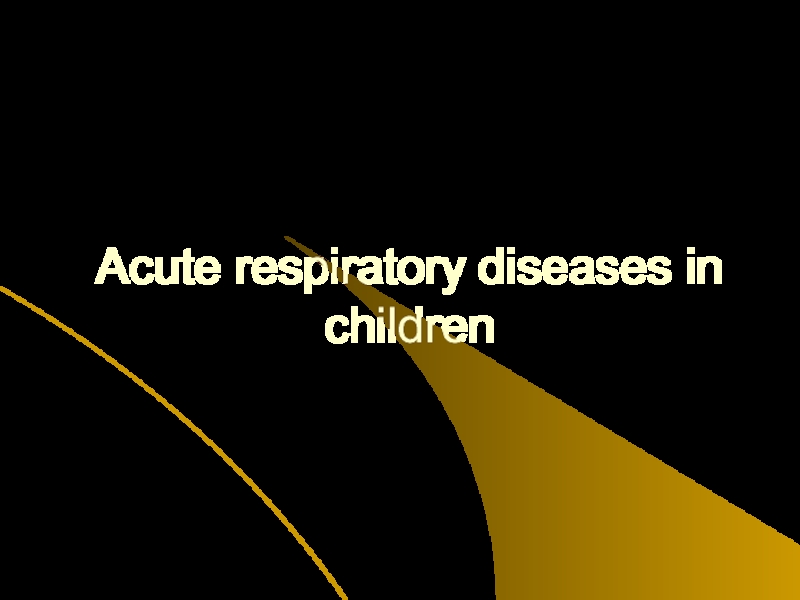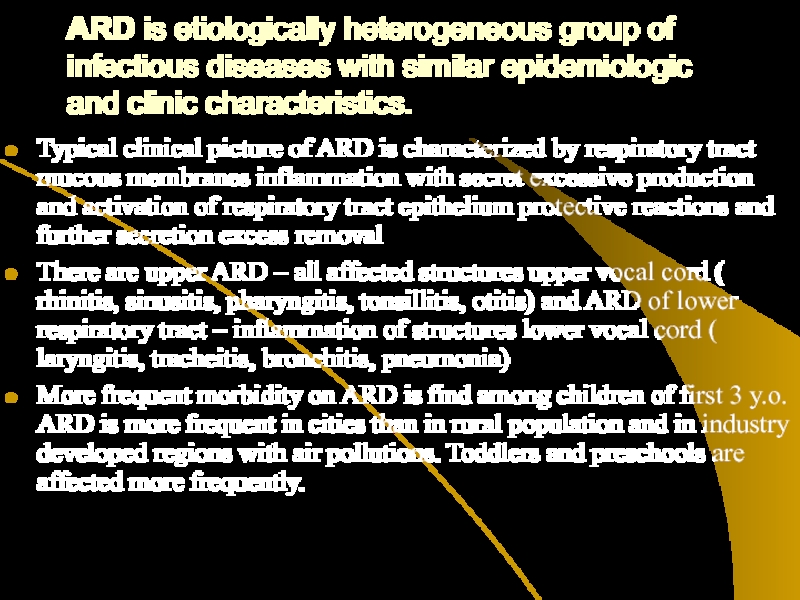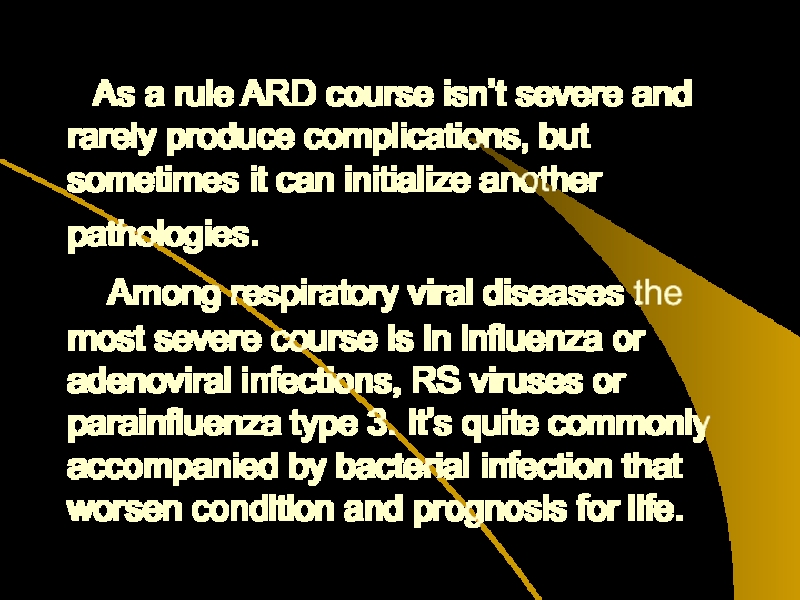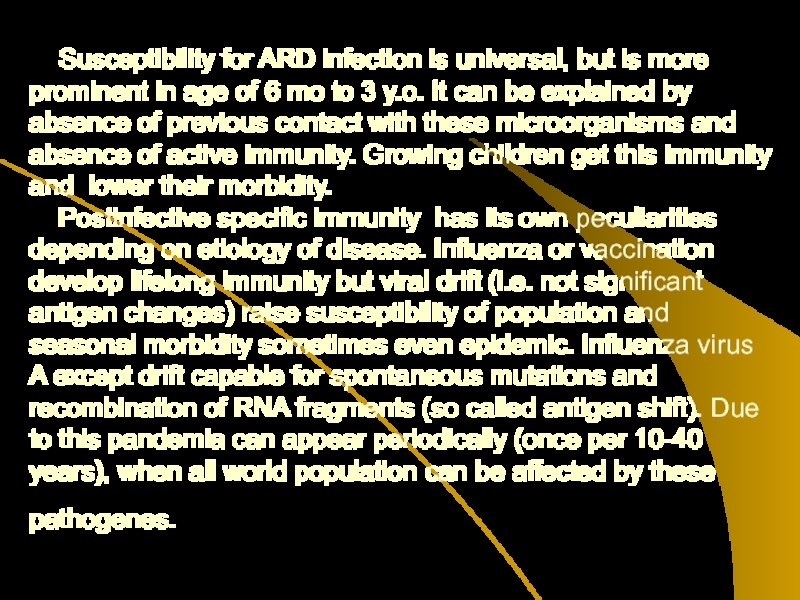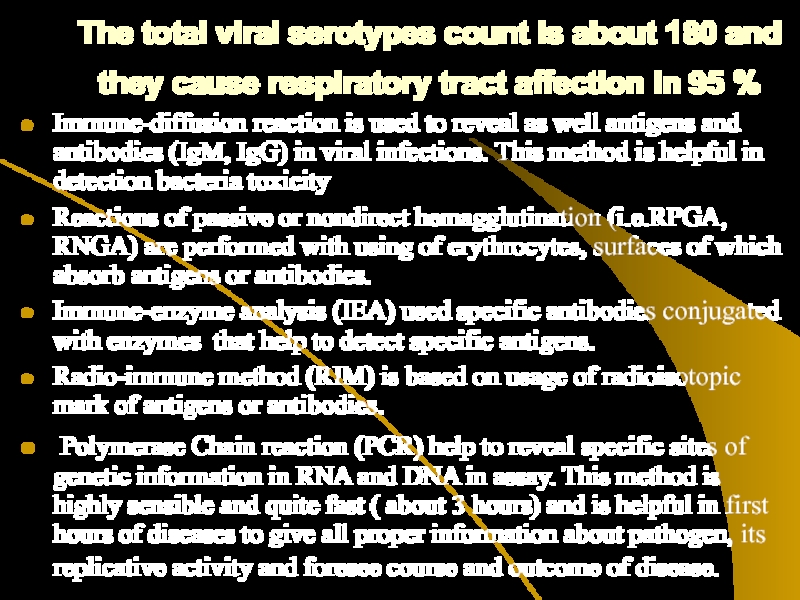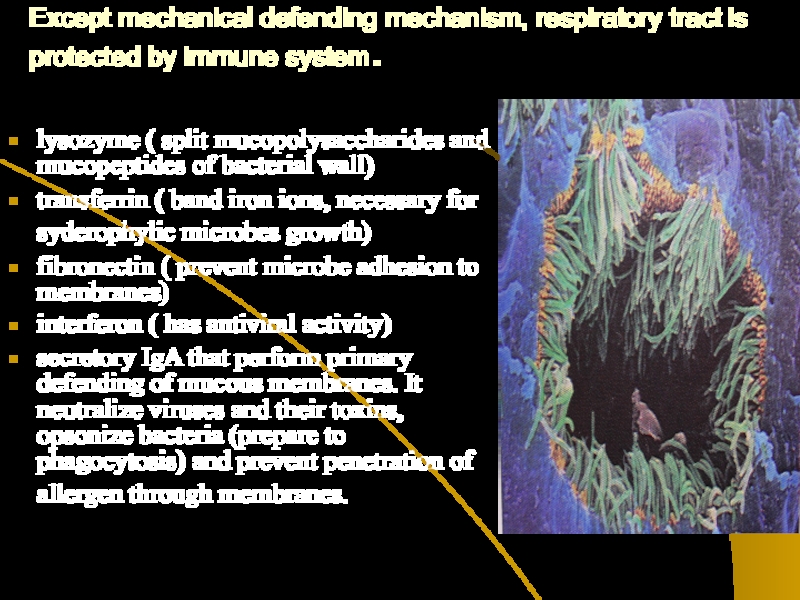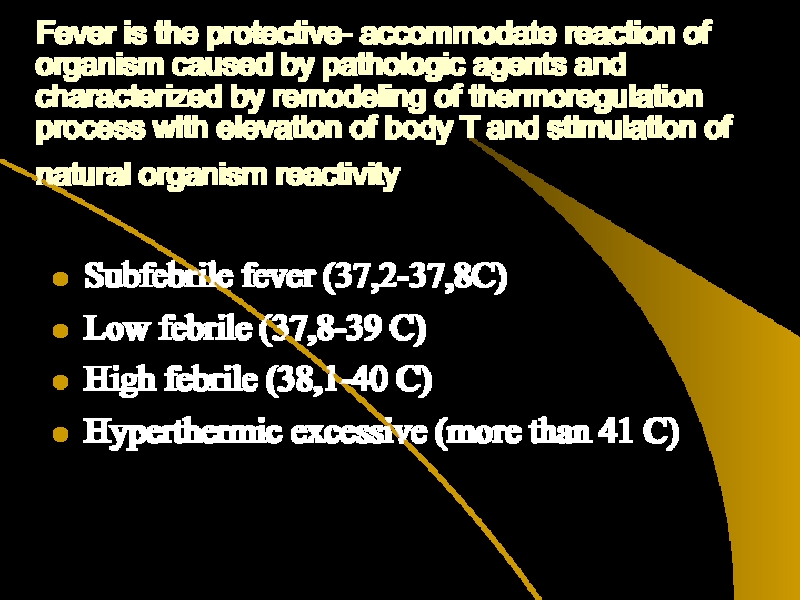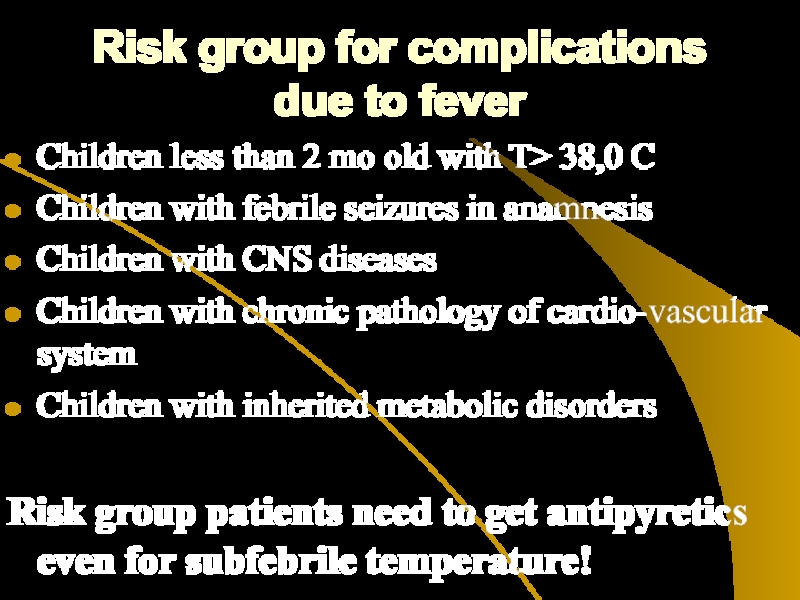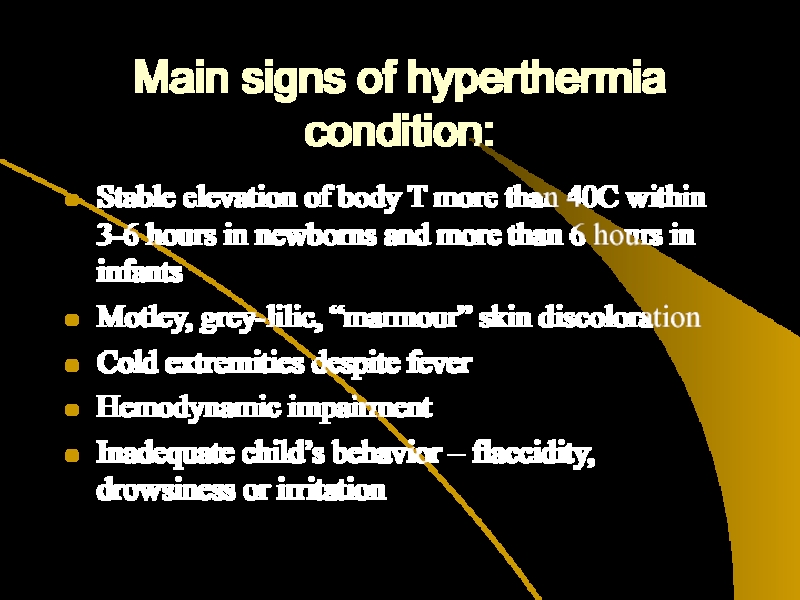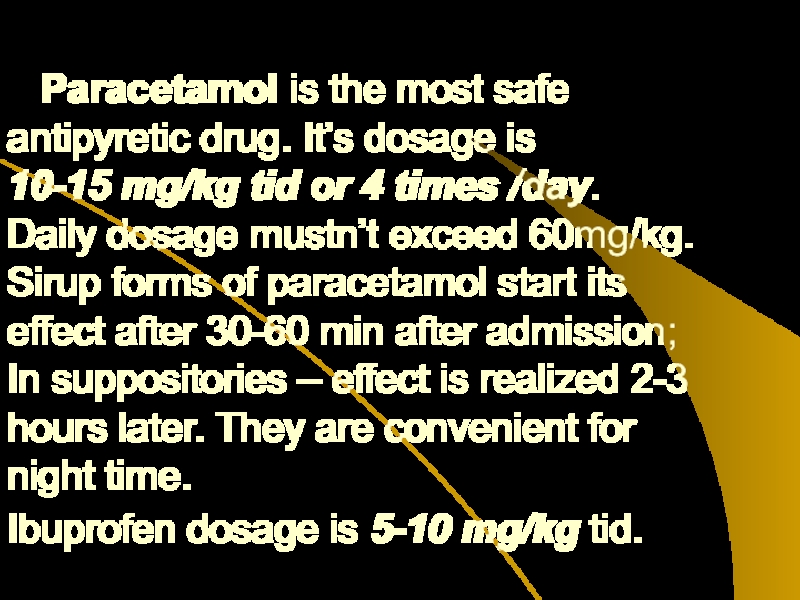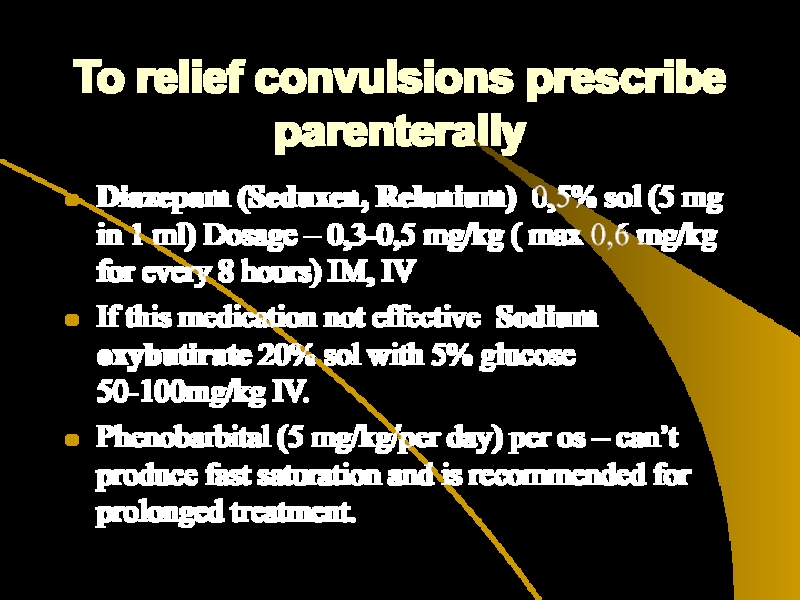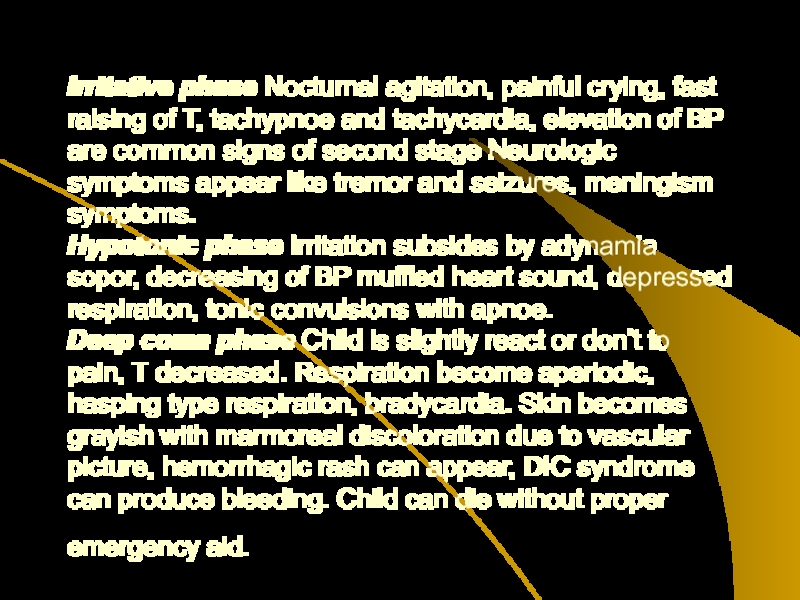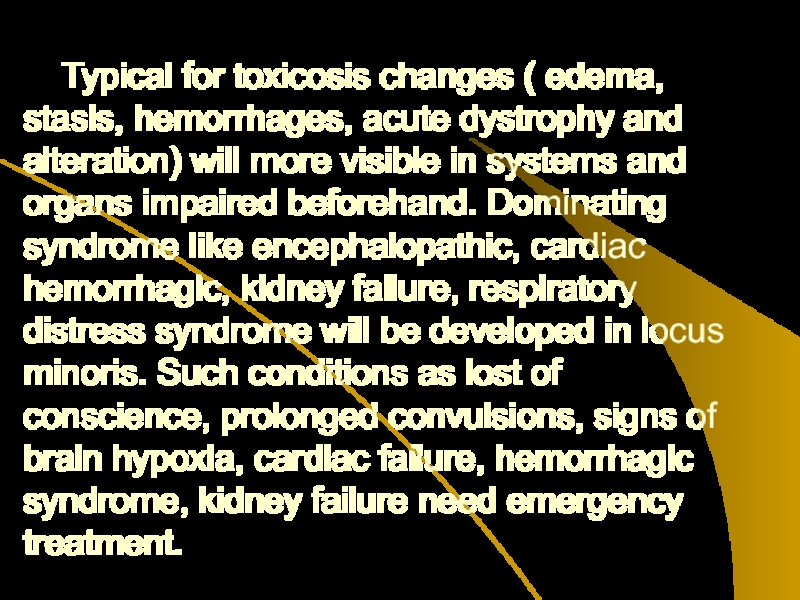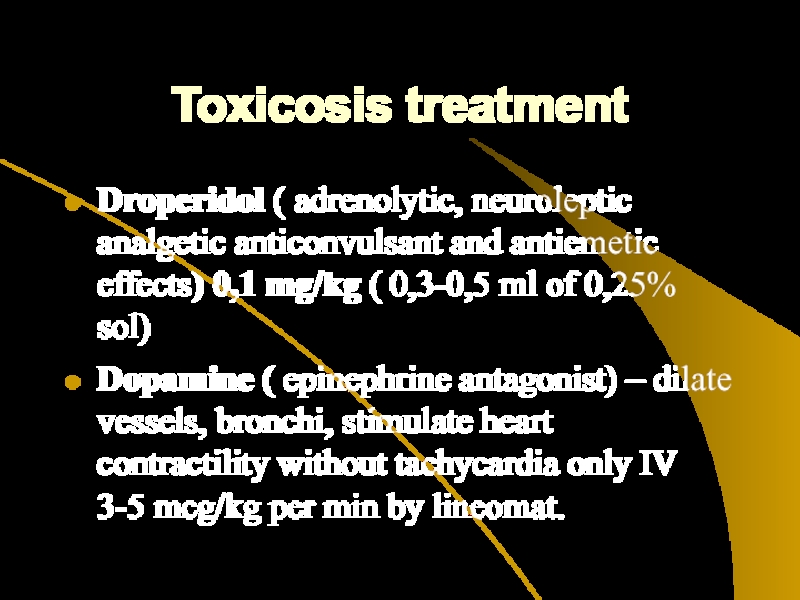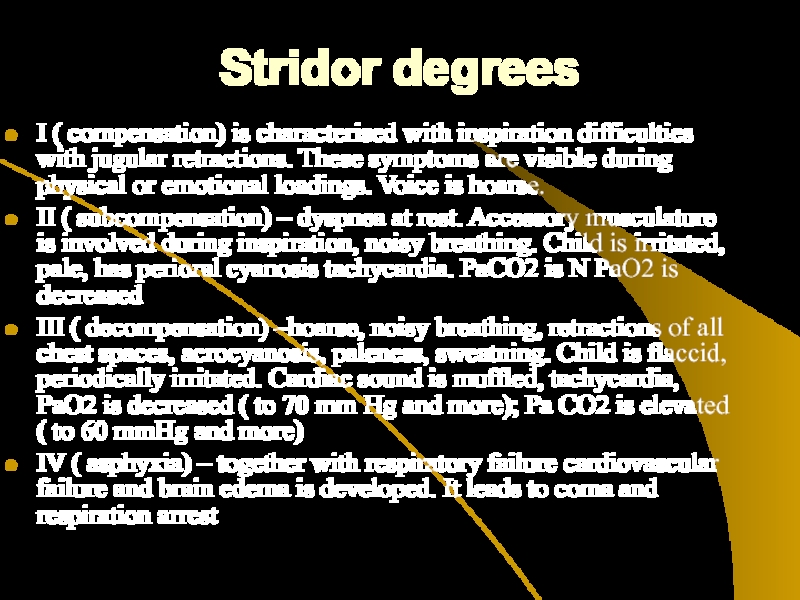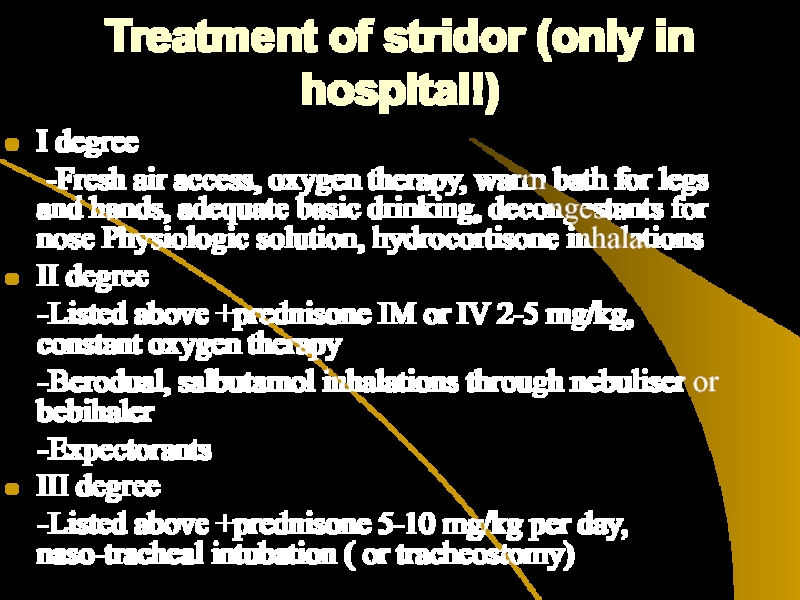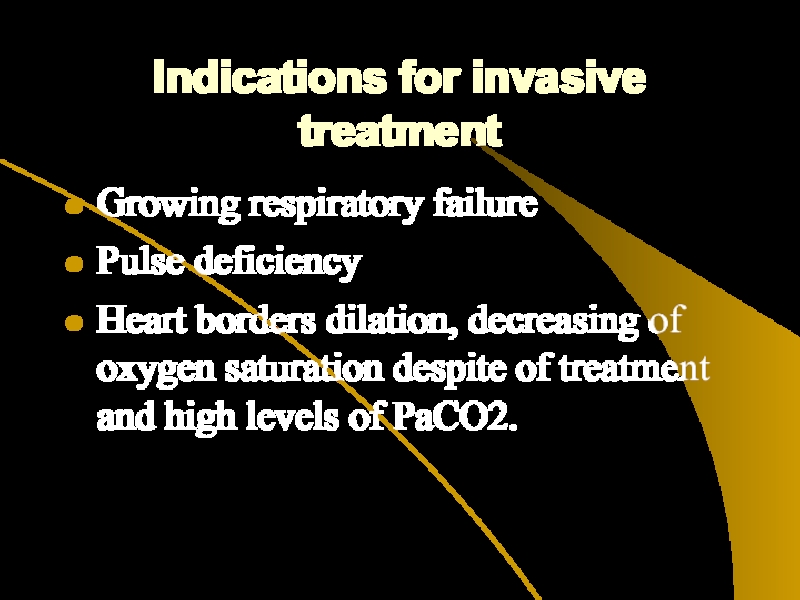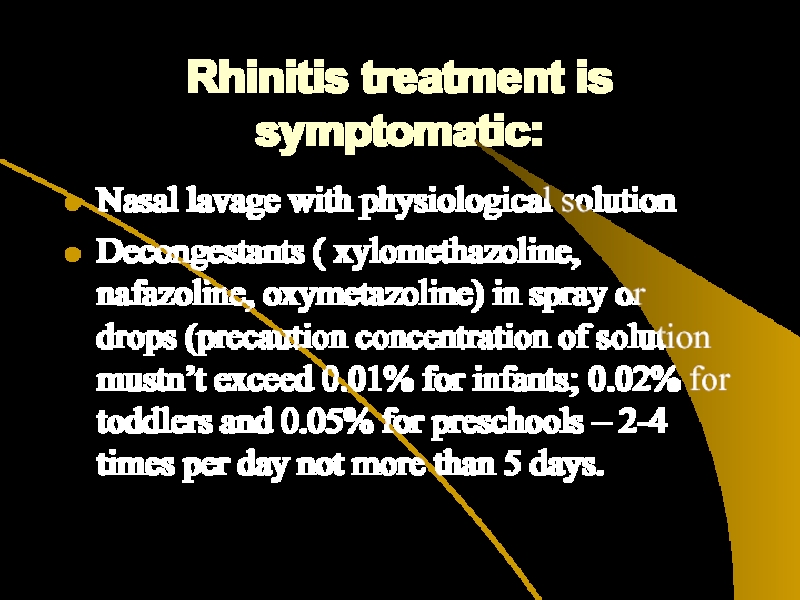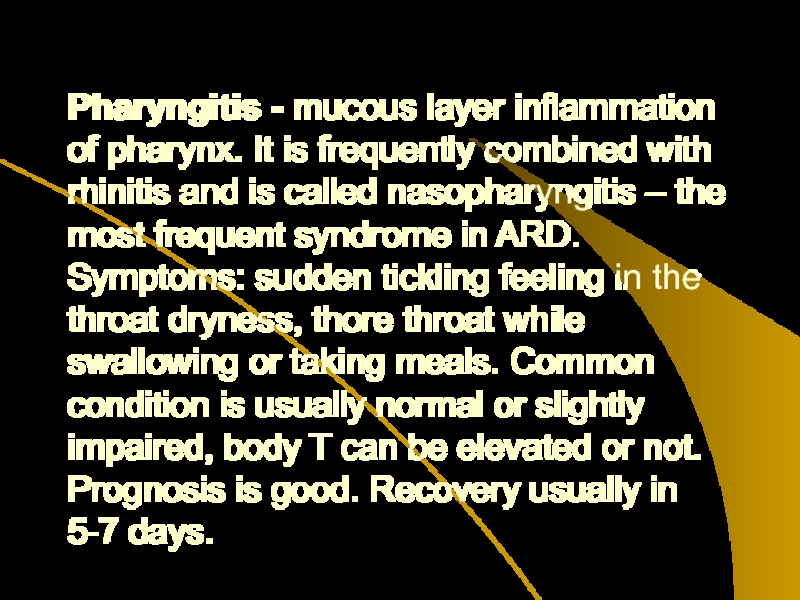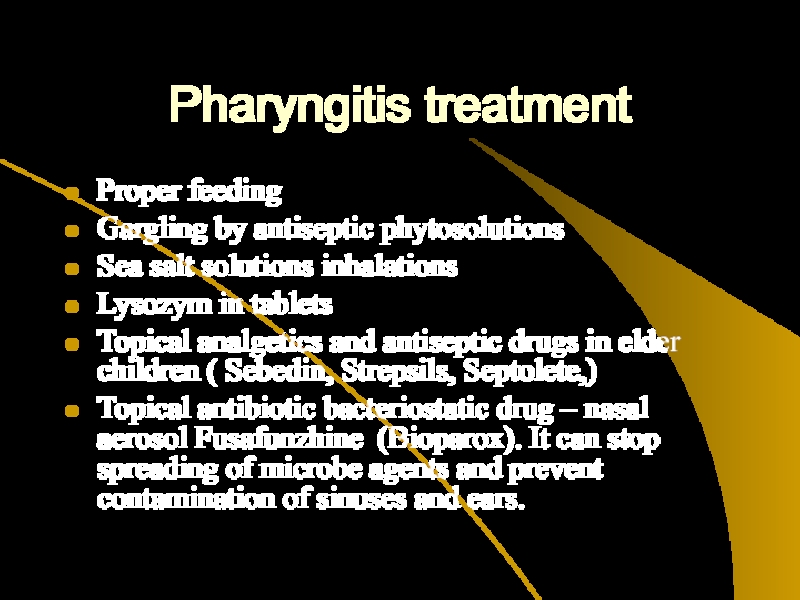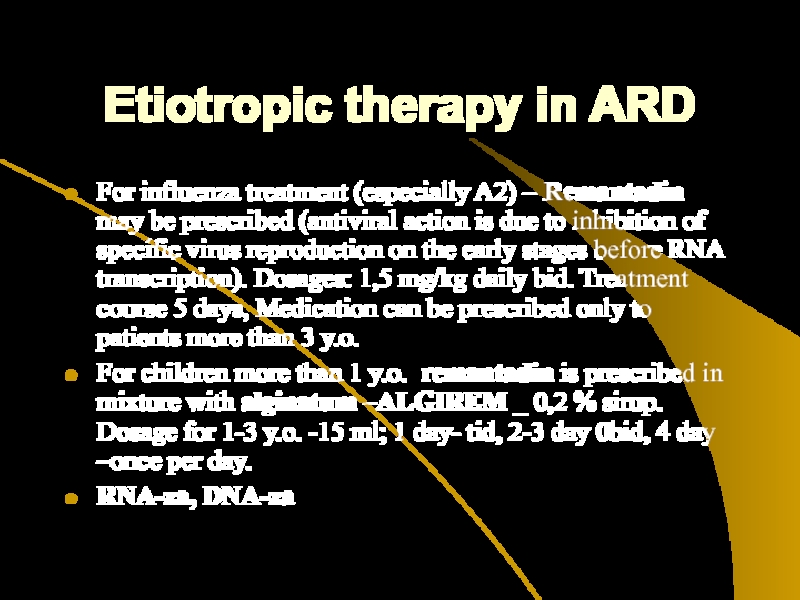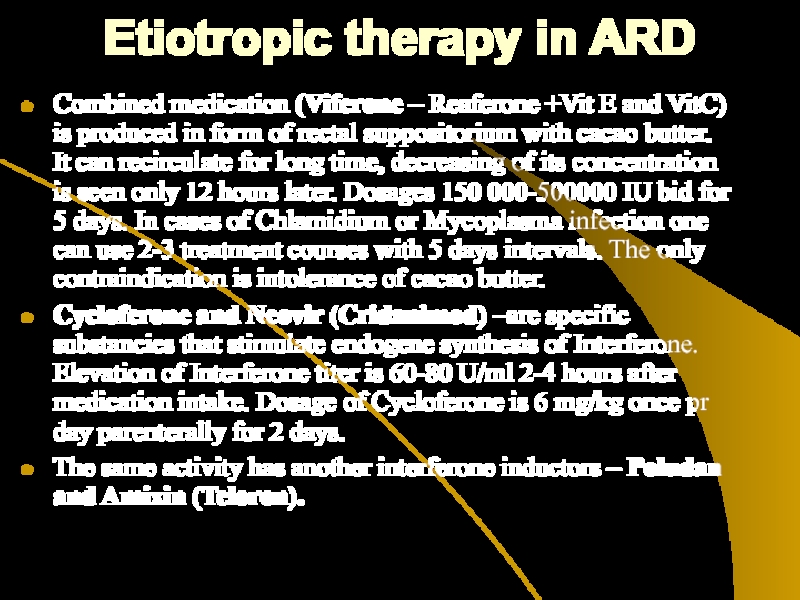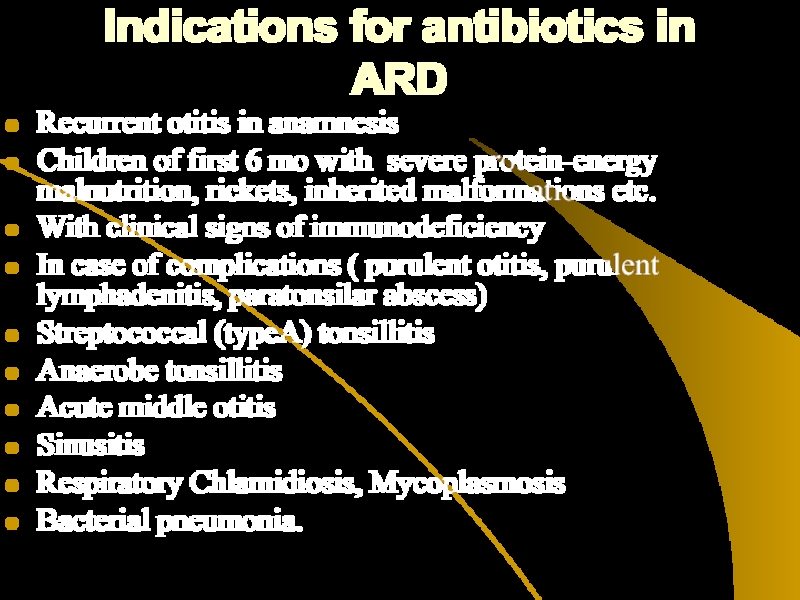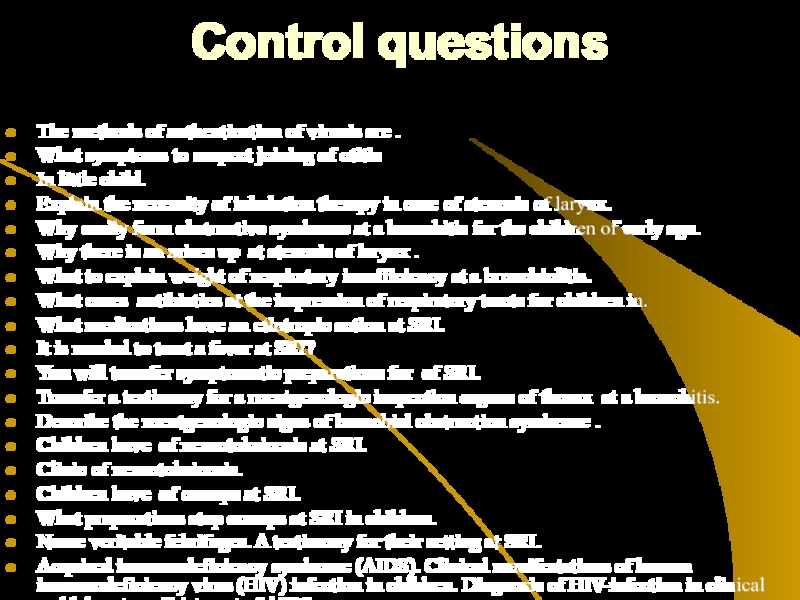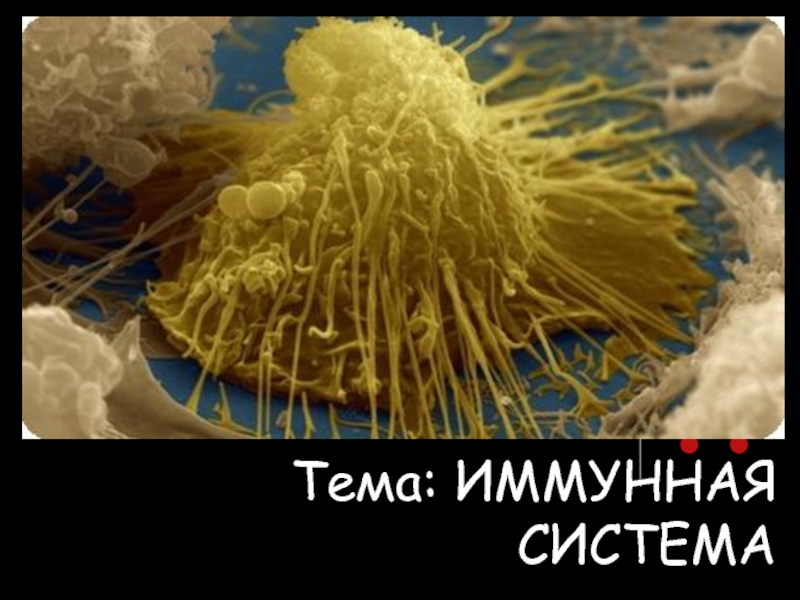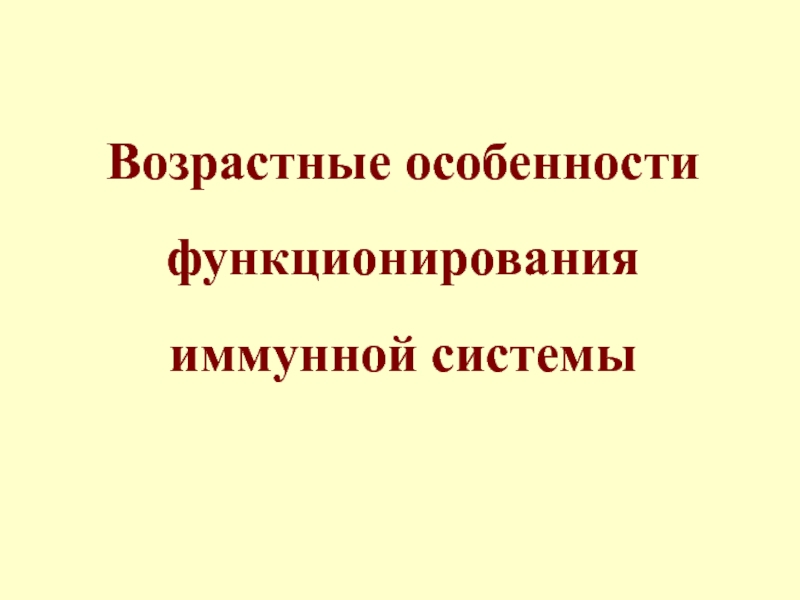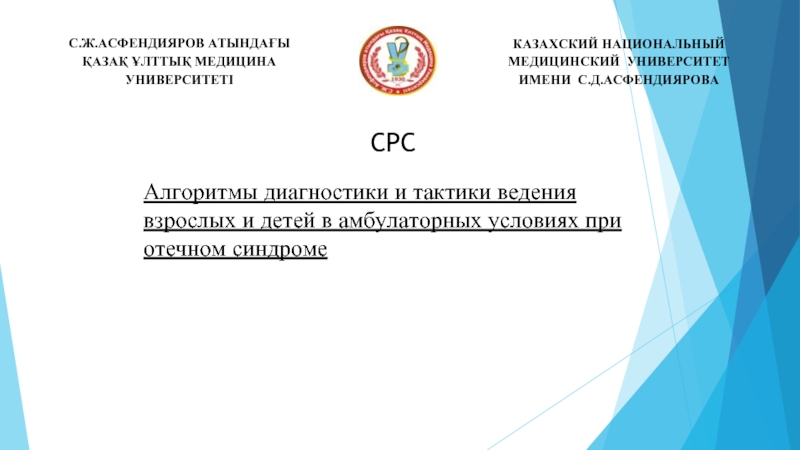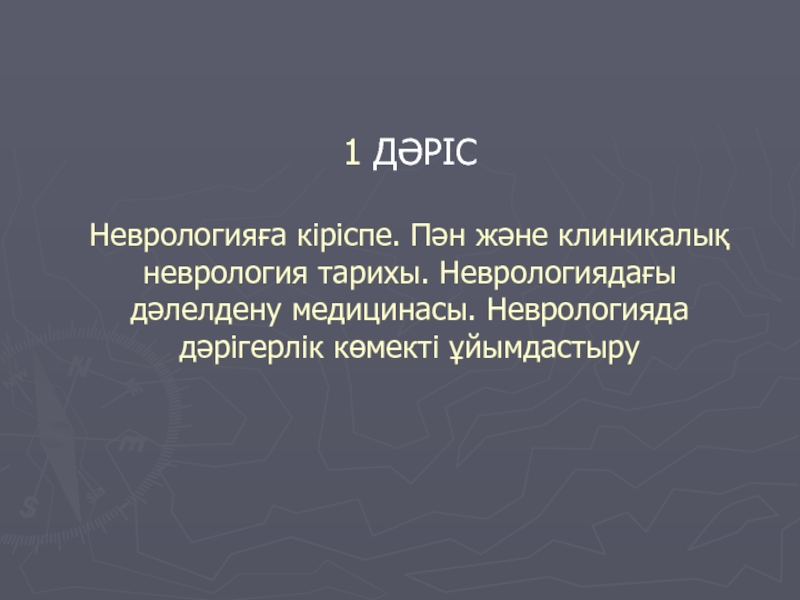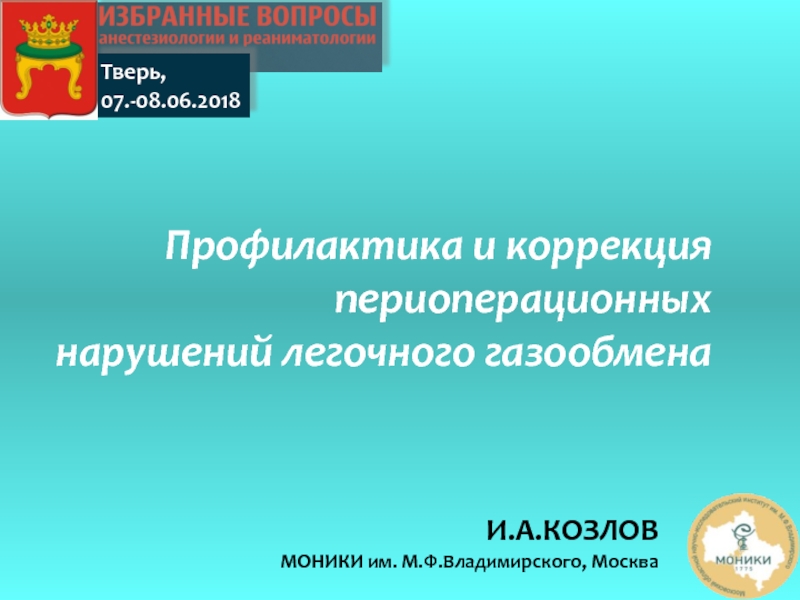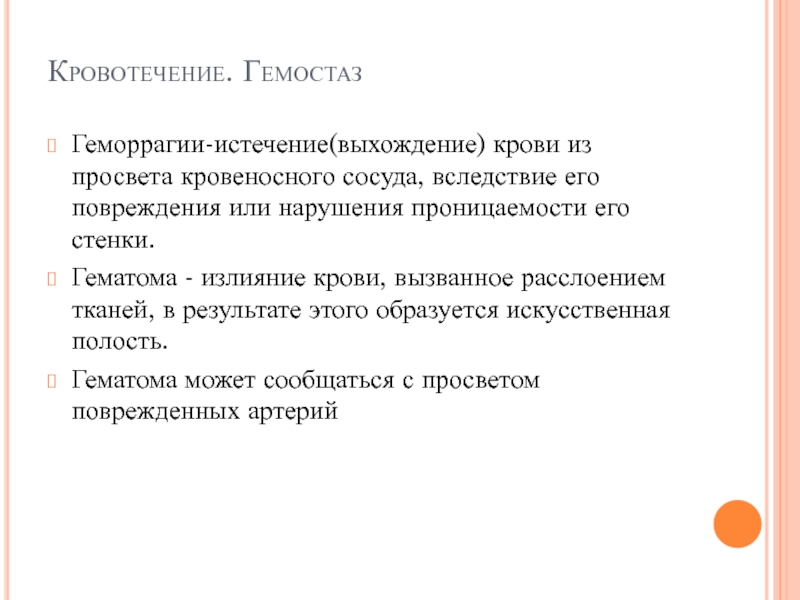- Главная
- Разное
- Дизайн
- Бизнес и предпринимательство
- Аналитика
- Образование
- Развлечения
- Красота и здоровье
- Финансы
- Государство
- Путешествия
- Спорт
- Недвижимость
- Армия
- Графика
- Культурология
- Еда и кулинария
- Лингвистика
- Английский язык
- Астрономия
- Алгебра
- Биология
- География
- Детские презентации
- Информатика
- История
- Литература
- Маркетинг
- Математика
- Медицина
- Менеджмент
- Музыка
- МХК
- Немецкий язык
- ОБЖ
- Обществознание
- Окружающий мир
- Педагогика
- Русский язык
- Технология
- Физика
- Философия
- Химия
- Шаблоны, картинки для презентаций
- Экология
- Экономика
- Юриспруденция
Acute respiratory diseases in children презентация
Содержание
- 1. Acute respiratory diseases in children
- 2. Plan of the lecture Etiology of
- 3. ARD is etiologically heterogeneous group of infectious
- 4. Etiology of ARD respiratory viruses
- 5. As a rule ARD course
- 6. Transmission mechanism in ARD Air way.
- 7. Susceptibility for ARD infection is
- 8. The total viral serotypes count is about
- 9. All viruses produce very similar clinical
- 10. Viral infection affect ciliary epithelium, suppress
- 11. Except mechanical defending mechanism, respiratory tract is
- 12. Neonates after birth are defended
- 13. Fever is the protective- accommodate reaction of
- 14. Types of fever “Pink fever” or moderate
- 15. Indications for antipyretic medications 1. For children
- 16. Risk group for complications due to fever
- 17. Hyperthermic syndrome is pathologic type of fever
- 18. Main signs of hyperthermia condition: Stable elevation
- 19. Medication choice in fever are Paracetamol
- 20. Paracetamol is the most safe
- 21. Lytic mixture is prescribed only for hyperthermia
- 22. If child has generalized convulsions it’s necessary
- 23. To relief convulsions prescribe parenterally Diazepam
- 24. Toxic syndrome –(acute infectious toxicosis, neurotoxicosis, toxic
- 25. Irritative phase Nocturnal agitation, painful crying, fast
- 26. Typical for toxicosis changes (
- 27. Toxicosis treatment Droperidol ( adrenolytic, neuroleptic
- 28. Neuro-vegetative protection is performed taking into account
- 29. Typical symptoms of stridor Voice mutation Noisy,
- 30. Stridor degrees I ( compensation) is characterised
- 31. Treatment of stridor (only in hospital!)
- 32. Indications for invasive treatment Growing respiratory failure
- 33. Clinical peculiarities and signs of ARD Rhinitis
- 34. Rhinitis treatment is symptomatic: Nasal lavage with
- 35. Pharyngitis - mucous layer inflammation of pharynx.
- 36. Pharyngitis treatment Proper feeding Gargling by antiseptic
- 37. Etiotropic therapy in ARD For influenza treatment
- 38. Etiotropic therapy in ARD Arbidol –interferon
- 39. Etiotropic therapy in ARD Interferones –are
- 40. Etiotropic therapy in ARD Combined medication
- 41. Indications for antibiotics in ARD Recurrent
- 42. Control questions The methods of authentication
Слайд 2Plan of the lecture
Etiology of ARD
Transmission mechanism in ARD
Hyperthermic syndrome
Toxic
Stridor
Clinical signs of ARD
Therapy in ARD
Слайд 3ARD is etiologically heterogeneous group of infectious diseases with similar epidemiologic
Typical clinical picture of ARD is characterized by respiratory tract mucous membranes inflammation with secret excessive production and activation of respiratory tract epithelium protective reactions and further secretion excess removal
There are upper ARD – all affected structures upper vocal cord ( rhinitis, sinusitis, pharyngitis, tonsillitis, otitis) and ARD of lower respiratory tract – inflammation of structures lower vocal cord ( laryngitis, tracheitis, bronchitis, pneumonia)
More frequent morbidity on ARD is find among children of first 3 y.o. ARD is more frequent in cities than in rural population and in industry developed regions with air pollutions. Toddlers and preschools are affected more frequently.
Слайд 4Etiology of ARD
respiratory viruses
enteroviruses
coronaviruses
bacteria
atypical microorganisms like
fungus
Слайд 5 As a rule ARD course isn’t severe and rarely
Слайд 6Transmission mechanism in ARD
Air way. Viruses has significantly minor sizes
Contact way (through dirty hands or by infected subjects as it can be in adenoviruses) also play its epidemiological role in infectious process, especially among children. In the case of bacterial ARD contact way is predominant.
Слайд 7 Susceptibility for ARD infection is universal, but is more
Слайд 8The total viral serotypes count is about 180 and they cause
Immune-diffusion reaction is used to reveal as well antigens and antibodies (IgM, IgG) in viral infections. This method is helpful in detection bacteria toxicity
Reactions of passive or nondirect hemagglutination (i.e.RPGA, RNGA) are performed with using of erythrocytes, surfaces of which absorb antigens or antibodies.
Immune-enzyme analysis (IEA) used specific antibodies conjugated with enzymes that help to detect specific antigens.
Radio-immune method (RIM) is based on usage of radioisotopic mark of antigens or antibodies.
Polymerase Chain reaction (PCR) help to reveal specific sites of genetic information in RNA and DNA in assay. This method is highly sensible and quite fast ( about 3 hours) and is helpful in first hours of diseases to give all proper information about pathogen, its replicative activity and foresee course and outcome of disease.
Слайд 9 All viruses produce very similar clinical picture – catarhhal events,
Слайд 10
Viral infection affect ciliary epithelium, suppress topical immunity of mucous membranes
Very important defending of respiratory tract mucous membranes is mucociliar clearance mechanism that remove sputum from bronchi.
Another defending mechanism is cough. It is helpful to remove sputum and particles from respiratory tract
respiratory tract is protected by immune system.
Слайд 11Except mechanical defending mechanism, respiratory tract is protected by immune system.
lysozyme ( split mucopolysaccharides and mucopeptides of bacterial wall)
transferrin ( band iron ions, necessary for syderophylic microbes growth)
fibronectin ( prevent microbe adhesion to membranes)
interferon ( has antiviral activity)
secretory IgA that perform primary defending of mucous membranes. It neutralize viruses and their toxins, opsonize bacteria (prepare to phagocytosis) and prevent penetration of allergen through membranes.
Слайд 12 Neonates after birth are defended by adequate immune response.
Слайд 13Fever is the protective- accommodate reaction of organism caused by pathologic
Subfebrile fever (37,2-37,8C)
Low febrile (37,8-39 C)
High febrile (38,1-40 C)
Hyperthermic excessive (more than 41 C)
Слайд 14Types of fever
“Pink fever” or moderate hyperemia of skin. Skin is
“Pale fever” – chill, paleness of skin, cool foots and hands, condition of child is disturbed ( heat emission isn’t equivalent to heat production due to impairment of peripheral microvasculature).
Слайд 15Indications for antipyretic medications
1. For children without anaemnestic problems
- manifested myalgias
- manifested head ache
2. For children with convulsions in anamnesis
- if body T more than 38,0 C
3. For children with pathology of heart and lungs
- if body T more than 38,5 C
4. For children of first 3 mo old
- if body T more than 38,0 C
Слайд 16Risk group for complications due to fever
Children less than 2
Children with febrile seizures in anamnesis
Children with CNS diseases
Children with chronic pathology of cardio-vascular system
Children with inherited metabolic disorders
Risk group patients need to get antipyretics even for subfebrile temperature!
Слайд 17Hyperthermic syndrome is pathologic type of fever when fast raising of
Слайд 18Main signs of hyperthermia condition:
Stable elevation of body T more than
Motley, grey-lilic, “marmour” skin discoloration
Cold extremities despite fever
Hemodynamic impairment
Inadequate child’s behavior – flaccidity, drowsiness or irritation
Слайд 19Medication choice in fever are
Paracetamol
Ibufen
Antifebrile action of antipyretics is based
Ibufen blocks COG in CNS in inflammative site ( antipyretic and antiinflammative effect)
Paracetamol inhibit prostoglandine synthesis predominantly in CNS ( antipyretic and analgetic effect).
Слайд 20 Paracetamol is the most safe antipyretic drug. It’s dosage
Слайд 21Lytic mixture is prescribed only for hyperthermia condition and “pale” fever
Analgini 50% sol 0,1-0,2 ml/10 kg
Diprasini 2,5% sol. (Pipolfeni) 0,01 ml/kg for infants 0,1-0,15 ml/per year for children more 1 year old
Papaverini hydrochloridi 2% sol – 0,1-0,2 ml for infants 0,2 ml/per year for elder children
Слайд 22If child has generalized convulsions it’s necessary
Turn him to one
Band his head backward for more easy breathing
Don’t open mouth by force because you can harm his teeth and produce aspiration
Inject anticonvulsants
If convulsions were eliminated but fever is still present give patient paracetamol
If both convulsions and fever continue inject lytic mixture IM
Слайд 23To relief convulsions prescribe parenterally
Diazepam (Seduxen, Relanium) 0,5% sol (5
If this medication not effective Sodium oxybutirate 20% sol with 5% glucose 50-100mg/kg IV.
Phenobarbital (5 mg/kg/per day) per os – can’t produce fast saturation and is recommended for prolonged treatment.
Слайд 24Toxic syndrome –(acute infectious toxicosis, neurotoxicosis, toxic encephalopathy) is typical for
Слайд 25Irritative phase Nocturnal agitation, painful crying, fast raising of T, tachypnoe
Слайд 26 Typical for toxicosis changes ( edema, stasis, hemorrhages, acute
Слайд 27Toxicosis treatment
Droperidol ( adrenolytic, neuroleptic analgetic anticonvulsant and antiemetic effects)
Dopamine ( epinephrine antagonist) – dilate vessels, bronchi, stimulate heart contractility without tachycardia only IV 3-5 mcg/kg per min by lineomat.
Слайд 28Neuro-vegetative protection is performed taking into account such rules:
Lytic mixture is
If there are signs of circulary failure (hypotonia, shoc) adrenomimetics are used in twice less dosage with IV infusions
Duration of neuro-vegetative blockage must be minimal
If there are signs of suprarenal gland failure glucocorticoids parenterally must be prescribed in daily dosage 10mng/kg equivalent to prednisone.
Слайд 29Typical symptoms of stridor
Voice mutation
Noisy, hoarse breathing
Tachypnoe
Obstructive, difficult inspiration ( in
In the case of croup progression ( 2 degree) accessory muscle of chest and neck involvement, jugular retractions, tachycardia, cyanosis.
Слайд 30Stridor degrees
I ( compensation) is characterised with inspiration difficulties with jugular
II ( subcompensation) – dyspnea at rest. Accessory musculature is involved during inspiration, noisy breathing. Child is irritated, pale, has perioral cyanosis tachycardia. PaCO2 is N PaO2 is decreased
III ( decompensation) –hoarse, noisy breathing, retractions of all chest spaces, acrocyanosis, paleness, sweatning. Child is flaccid, periodically irritated. Cardiac sound is muffled, tachycardia, PaO2 is decreased ( to 70 mm Hg and more); Pa CO2 is elevated ( to 60 mmHg and more)
IV ( asphyxia) – together with respiratory failure cardiovascular failure and brain edema is developed. It leads to coma and respiration arrest
Слайд 31Treatment of stridor (only in hospital!)
I degree
-Fresh
II degree
-Listed above +prednisone IM or IV 2-5 mg/kg, constant oxygen therapy
-Berodual, salbutamol inhalations through nebuliser or bebihaler
-Expectorants
III degree
-Listed above +prednisone 5-10 mg/kg per day, naso-tracheal intubation ( or tracheostomy)
Слайд 32Indications for invasive treatment
Growing respiratory failure
Pulse deficiency
Heart borders dilation, decreasing of
Слайд 33Clinical peculiarities and signs of ARD
Rhinitis can be isolated or combined
Clinical signs: sneezing, rhinorrhea (nasal mucus discharges), impaired nasal breathing (can be essential in breast feeding abnormality in infants). Mucus run-off by pharynx and can produce cough, especially at night. Cough is stimulated by dryness of mucous because of respiration through mouth. If nasal discharges prolonged more than 10-14 days it’s indicative for sinusitis
Слайд 34Rhinitis treatment is symptomatic:
Nasal lavage with physiological solution
Decongestants ( xylomethazoline, nafazoline,
Слайд 35Pharyngitis - mucous layer inflammation of pharynx. It is frequently combined
Слайд 36Pharyngitis treatment
Proper feeding
Gargling by antiseptic phytosolutions
Sea salt solutions inhalations
Lysozym in tablets
Topical
Topical antibiotic bacteriostatic drug – nasal aerosol Fusafunzhine (Bioparox). It can stop spreading of microbe agents and prevent contamination of sinuses and ears.
Слайд 37Etiotropic therapy in ARD
For influenza treatment (especially A2) – Remantadin may
For children more than 1 y.o. remantadin is prescribed in mixture with alginatum –ALGIREM _ 0,2 % sirup. Dosage for 1-3 y.o. -15 ml; 1 day- tid, 2-3 day 0bid, 4 day –once per day.
RNA-za, DNA-za
Слайд 38Etiotropic therapy in ARD
Arbidol –interferon inductor. Dosages 6-12 y.o.0,1, 12
Anaferon contain purified antibodies for interferon –γ of humans. Drug stimulate humoral and cell response, raise antibodies production including IgA, activates T-effectors, T-helpers function, normalize its ratio.
Ribavirin (nucleotide analogue of guanozine)- is used in RS viral bronchitis, bronchiolities in severe cases. Dosage 20 mg/kg/daily in form of aerosol through inhaler. In USA monoclonal antibodies to RS viral F-protein used and it help rapidly decrease virus quantity in respiratory tract. Inhibitors of neraminidase (Zanamivir –Relenca) – inhalations 20 mg bid, Ozeltamivir –Tamiflu ) 2 mg/kg bid are allowed for children of 5 y/o/ and elder These medications shorten fever and all symptoms duration for 24-36 hours. They can prevent flu development.
Слайд 39Etiotropic therapy in ARD
Interferones –are proteins that are synthesized by
For influenza and ARD treatment leucocyte interferone (1000 IU) can be used. It is used intranasaly in dosage 2 ml. Recombinant interferon ( Reaferon, Roferon) is more active (10 000 IU/ml) and is prescribed at the first signs of ARD intranasaly 3-4 drops every 15-20 min for 3-4 hours, then 4-5 times per day within 3-4 days.
Слайд 40Etiotropic therapy in ARD
Combined medication (Viferone – Reaferone +Vit E
Cycloferone and Neovir (Cridanimod) –are specific substancies that stimulate endogene synthesis of Interferone. Elevation of Interferone titer is 60-80 U/ml 2-4 hours after medication intake. Dosage of Cycloferone is 6 mg/kg once pr day parenterally for 2 days.
The same activity has another interferone inductors – Poludan and Amixin (Teloron).
Слайд 41Indications for antibiotics in ARD
Recurrent otitis in anamnesis
Children of first
With clinical signs of immunodeficiency
In case of complications ( purulent otitis, purulent lymphadenitis, paratonsilar abscess)
Streptococcal (typeA) tonsillitis
Anaerobe tonsillitis
Acute middle otitis
Sinusitis
Respiratory Chlamidiosis, Mycoplasmosis
Bacterial pneumonia.
Слайд 42Control questions
The methods of authentication of virusis are .
What symptoms to
In little child.
Explain the necessity of inhalation therapy in case of stenosis of larynx.
Why easily form obstructive syndrome at a bronchitis for the children of early age.
Why there is an arises up at stenosis of larynx .
What to explain weight of respiratory insufficiency at a bronchiolitis.
What cases antibiotics at the impression of respiratory tracts for children in.
What medications have an etiotropic action at SRI.
It is needed to treat a fever at SRI?
You will transfer symptomatic preparations for of SRI.
Transfer a testimony for a roentgenologic inspection organs of thorax at a bronchitis.
Describe the roentgenologic signs of bronchial obstruction syndrome .
Children have of neurotoksicosis at SRI.
Clinic of neurotoksicosis.
Children have of cramps at SRI.
What preparations stop cramps at SRI in children.
Name veritable febrifuges. A testimony for their setting at SRI.
Acquired immunodeficiency syndrome (AIDS). Clinical manifestations of human immunodeficiency virus (HIV) infection in children. Diagnosis of HIV-infection in clinical and laboratory. Triatment of AIDS.
